Gurley Hand-Nivellierer |
Gurley Hand Level |
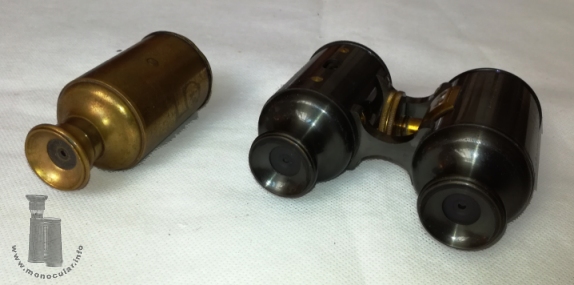

| Die Firma W. & L.E. Gurley aus Troy, NY stellte vorrangig Landvermessunggeräte in der optischen Sparte her. Von den in 1886 patentiertem Handnivellier (patent #353,406) in Locke-Bauart gab es eine monokulare und binokulare Version, wobei beide nur eine Durchsicht durch ein Galileisches Glas mit ca. 2-2,5facher Vergrößerung und 32mm Objektiv ermöglichen. Das Monokular kombinierte in einem Tubus sowohl die Nivellierung als auch den Blick auf das anvisierte Objekt, während bei dem binokularen Modell die Nivelliereinheit im linken Objektiv-losen, durch einen Metalldeckel geschlossenen Tubus und die Objektanvisierung im rechten normalen Galileishcen Glas (Tubus) stattfindet. (Vgl. unten Beschreibung im Gurley-Handbuch) Zum Nivellieren wird durch einen länglich-ovalen Schlitz von oben Licht durch eine Blasen-Wasserwaage geschickt, mit einem dünnen 90°-Prisma zum Okular geleitet. Dort kann beim monokularen Modell links im Sichtfeld, beim binokularen nur alleine im Sichtfeld (das Objektivende ist mit einem Deckel verschlossen) die Zentrierung eiens Strichs in der Blase abgelesen werden, womit eine waagerechte Nivellierung erreicht wäre. Im Monokular wird rechts davon eine Anvisierung durch die Objektivlinse auf das Geländeobjekt gemacht werden. Somit geschieht dies gleichzeitig mit einem Auge. Die Fokussierung wird durch Heraus- und Hineinschieben des Okularstücks erreicht. Beim Binokular ist die rechte Hälfte ein normales Galileiglas zum Anvisieren des Geländeobjekts. Zum Fokussieren wird ein Drehrad zwischen den Brückenarmen und Tuben genutzt, wodurch per Zahntrieb das Objektiv verschoben wird. |
The W. & L.E. Gurley company in Troy, NY mainly built land surveying instruments regarding the optical branch. The hand level patented in 1886 (patent #353,406) was made in two versions, a monocular and a binocular after a construction by Locke. Both versions allow an object view only through one Galilean glas with a approximately 2-2.5 times power and a 32mm objective lens. The monocular combined the leveling as well as the magnified view in one tube, whereas the binocular model had the leveling unit within the left tube, which had no objective lens, but a metal cover, and had the object image in the rigth regular Galilean glas (tube). (cf. description in the Gurley manual below) When in use, light passes through an oval slot ont he top into a bubble vial and is diverted by a slender 90° prism into the ocular. So, you can observe the centering of a wire line over the bubble meaning the correct leveling - this information is seen in the left half of the image of the monocular model, while it is the only image in the left utbe of the binocular. In the monocular model the image shows the observed object seen through the objective lens. So you have both information simultaneously in one eye. Focusing is done by sliding the eyepeice in and out. The binocular's right half is a normal Galilean glass to aim at the obejct. Focusing is done here by truning a wheel between the bridge arms or tubes moving the objective lens with a rack and pinion system. |
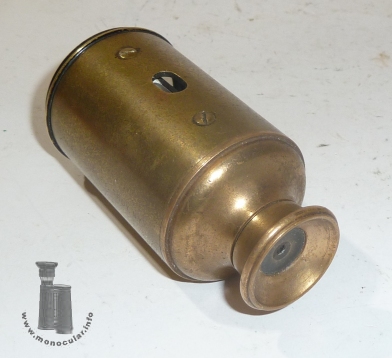
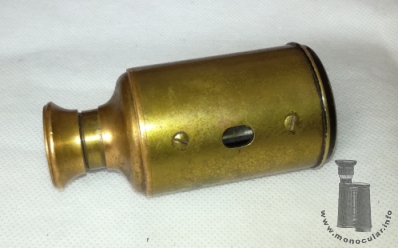
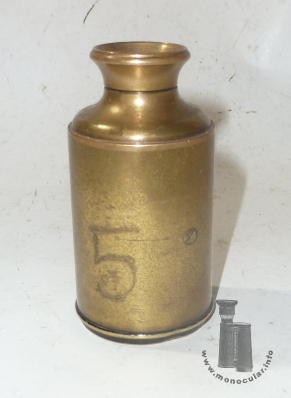
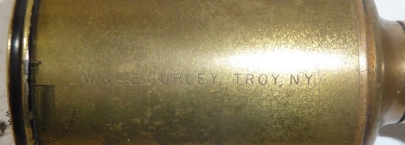
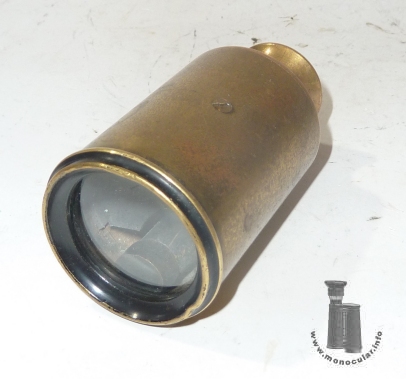
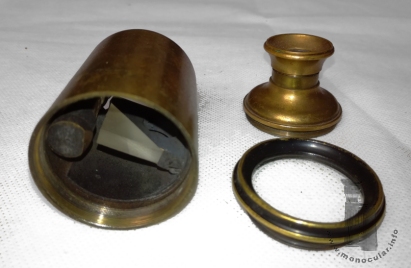
| Die Handnivellierer sind aus Merssing, das binokulare Modell ist noch schwarz lackiert, einige Messingteile sind zaponiert. Der Firmenname ist jeweils auf einem Tubus eingraviert. Das Monokualr wiegt 257g, das Binokular 532g. Die Tubusse sind 55mm lang und 42mm im Durchmesser. Die Gesamlänge ist 79-84mm bzw. bis 87mm beim Binokular. Letzteres ist 103mm breit. Die Okularstücke sind 19mm und die Metallaugenmuschel 27mm im Durchmnessser. |
The hand levels are made of brass, the binocualr mdoel is still lacquered black, some brass parts are treated with zapon. The maker's name is marked on one tube. The monocular weighs 257g, the binocular 532g. The tubes are 55mm long and 42mm in diameter. The overall length is 79-84mm or to 87mm for the binocualr. The latter is 103mm wide. The eyepeices are 19mm and the metal eyecups 27mm in diameter. |
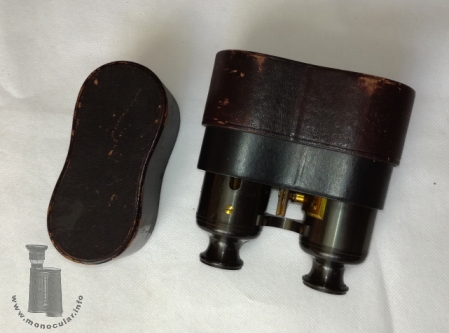
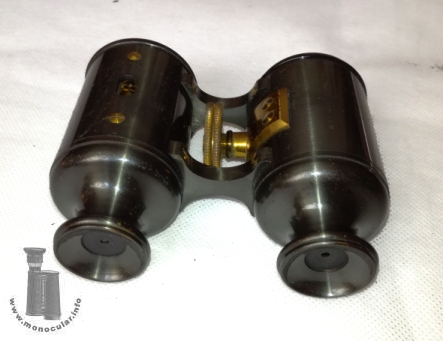
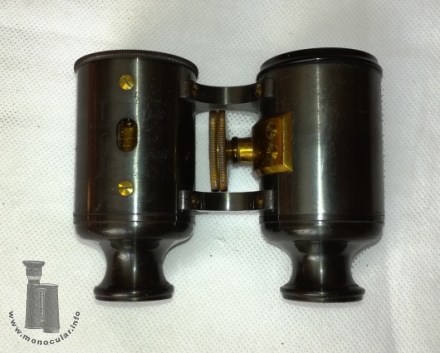
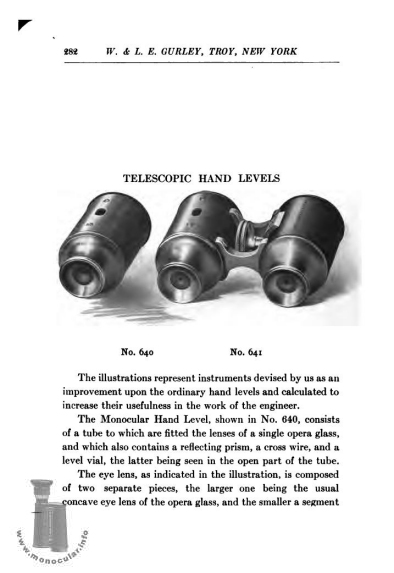
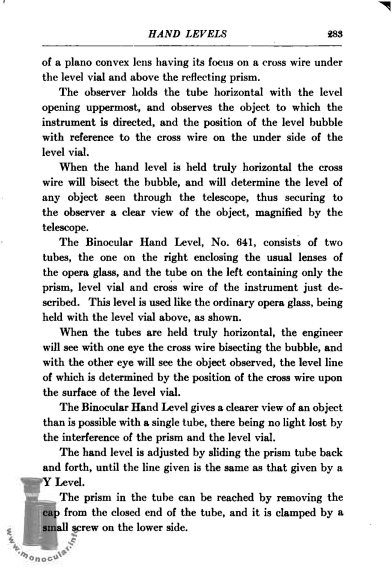
| Siehe auch: Amer. Hstory Museum Sammlung | Cf. also a href="https://americanhistory.si.edu/collections/search/object/nmah_761997" target="_blank">Amer. Hstory Museum Collection |
Fotos: Zeun

